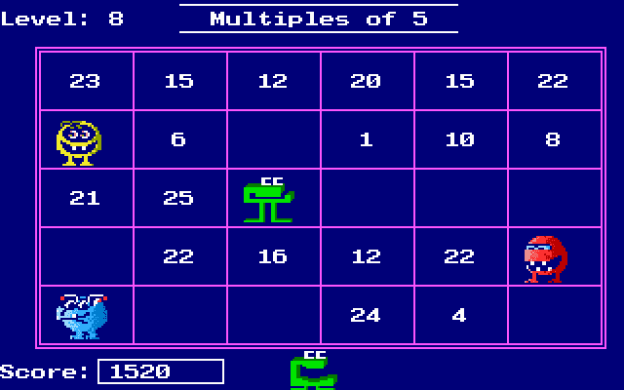Early Math and Video Games
I don’t recall any of my teacher’s math lessons from fourth grade; however, I do have vivid memories of playing Number Munchers. Number Munchers was a fairly simple video game that was similar to Pac Man. In the game, you had to move a little green frog like character around a grid filled with numbers while avoiding monster called Troggles. You earned points and advancement to the next levels by eating all of a certain kind of number such as primes or multiples of 4 that were in the grid. I was obsessed with playing that game during recess and computer time. It was not just me who enjoyed playing the game; there was always a line of students who were waiting for their turn to play the game. Furthermore, often we would watch our friends play the game and shout out advice like “eat the number 49 it is a multiple of 7!” I don’t have any proof that Number Munchers helped me learn math concepts, but like I said I remember playing the game more than any math activities from Elementary School.
Flash forward 20 years and now I am teaching Pre-K. What do my 4 and 5 year old students like to do more than anything else including playing with blocks, going outside, and eating snack? Play on the classroom computer. The big difference though is that for me Number Munchers and similar games were a kind of interesting novelty that had simplistic graphics and game play. Today’s students have been surrounded by an ever expanding array of electronic devices such as laptops, iPads, and smart phones that can run intricate programs and applications that would make Number Munchers look like an ancient artifact. As electronic devices continue to infiltrate all aspects of our life, it stands to reason that the classroom will be no exception. In fact, some have characterized today’s generation of students as “digital natives” as opposed to “digital immigrants” of older generations. These new digital technologies and environments have resulted in a new generation that thinks and processes information differently than older generations and may have actually affected the organization of current students’ brains. (Prensky 2006 p. 28) Thus, we must examine how effective computer games are in teaching school curriculum. In the following paragraph I will review the research of the efficacy of computer based instruction with a particular focus on mathematics instruction in Elementary School.
In video games, the words playing and learning are pretty much synonymous. A player can not advance to the next level or challenge of a game without first learning and mastering how to play the game. In some ways all learning is learning how to play the game. Math, Biology, Literacy Et.Al. are all like different kinds of games with different rules and goals. In addition, most games are very long and have a challenging level of difficulty and yet still manage to get players engaged. (Gee 2007 p.7) Thus, I think it important that we look at why games in general are able to hold player’s interests even when they difficult in order to have a baseline understanding of game design and how it might later relate to our more specific look into the games designed to build mathematical knowledge and skills. There are many principals of learning built into good video games such as customization, taking on a new identity, well ordered problems, being pleasantly frustrating, information given at the time when it will be put in use, and using skills as a strategy to accomplish a larger goal. (Gee 2004) Now that we have established a parallel between playing video games and learning, let’s look specifically at video games and their potential in mathematics instruction.
Mathematics is obviously a very broad academic discipline. Before we look at the efficacy of computer games in math Elementary School math instruction, it is important that we narrow the scope of the term “mathematics” to the type of mathematics that students will most likely encounter in an Elementary School setting. The Massachusetts Department of Education has detailed frameworks for the mathematicalknowledge and skills Elementary Schools students are expected to have. Below, I have listed a few examples from Massachusetts state standards for Elementary School Mathematics: (the first letter/number represents the grade as in K for Kindergarten and 2 for Second Grade)
• K.N.1 Count by ones to at least 20. :
• K.N.2 Match quantities up to at least 10 with numerals and words
• 2.N.3 Identify and represent common fractions (1⁄2, 1⁄3, 1⁄4) as parts of wholes, parts of groups,
• and numbers on the number line. :
• 2.N.4 Compare whole numbers using terms and symbols, e.g., less than, equal to, greater than
(<, =, >). :
• 2.N.5 Identify odd and even numbers and determine whether a set of objects has an odd or even
number of elements. :
• 4.N.10 Select and use appropriate operations (addition, subtraction, multiplication, and
division) to solve problems, including those involving money. l
• 4.N.11 Know multiplication facts through 12 12 and related division facts.
Use these facts to solve related multiplication problems and compute (Driscoll 2000)
There have been many games that have been created in order to teach the knowledge and skills that go into meeting the standard in Elementary School mathematics. Now I will look at some of those specific games effectiveness
Two researchers Din and Calao conducted a study on the Sony Playstation video game series called Lightspan which were educational video games marketed to schools. The study was conducted using a group of urban kindergarten who were all from lower from families with lower socioeconomic status. The students were divided into experimental and control groups. (24 students in the experimental and 23 in the control) The students in the both groups received the same curriculum with the exception of the students in the experimental group playing the Lightspan games for 40 minutes a day, 5 days a week, for 11 weeks, and being given a copy of the Lightspan game to play at home. The students were given pre and post-tests in order to determine the effects if any of the experimental group playing the Lightspan games. The results of the study showed that students in the experimental group made gains that were only slightly higher than the control group in the mathematics post-test. The slightly higher gains were considered statistically insignificant by the researchers. In addition, a post-test done on reading skills did show statistically significant improvements for students who used the Lightspan games. (Din, F., & Cakao, J. 2001) This last fact about the different result for reading and math skills could have been the result of a number of factors. 1. That something about mathematics does not translate well to learning via video games 2. The Lightspan games may have been more effectively designed when it came to reading instruction vs. mathematical instruction. 3. The students may not have had the background knowledge or developmental maturity to learn the new mathematical skills the Lightspan games intended to teach. There have not been enough other studies regarding Lightspan to determine which factor led to the divergent results, but looking at other studies regarding video games mathematical instruction will help us find if this was a peculiarity regarding light span, or a general trend of video games not helping mathematical understanding.
A different video game program called Skills Arena was specifically designed for Nintendo’s Game Boy Advanced hand held video games system. The program uses classic math drills where students have to answer addition and subtraction problems in order to receive points in the game. Before solving the problems, players create a character to represent them in the game and their character competes for points in the game against computer based characters. Each computer based character is at a different level of difficulty. Players in the game are given both instant feedback regarding if they answered a problem correctly and long term feedback that shows the cumulative progress of their digital character for all the matches. (Lee, J, Luchini, K et al 2004) In the study, the Skills Arena game was given to students in second grade classroom in a middle class Michigan city for 19 days. No formal instruction was given to teachers as to how to incorporate the game into the classroom which resulted in the game being used 10 minutes each day as part of a math lesson to being used as a reward to students who finished their assignments. Teachers and the researchers observing the class reported the students seemed to have little trouble using the game, would often help out another student who was having difficulty with an aspect of the game, that it was easy for the teacher to oversee use of the game, and that the students seemed engaged by the game and the ability to create their own character in the game. In addition, by adding the Skills Arena game to the classroom, the students solved 3 times as many math problems per day compared to normal classroom curriculum. (Lee, J, Luchini, K et al 2004) All of thoseanecdotal and qualitativresults seem positive; however the study did not provide any real hard data regarding outcomes on things like standardized tests, grades, or other assessments of mathematical ability.
On the other hand, The University of Michigan also did a study regarding Skills Arena’s effectiveness that did provide some quantitative data. In that study of third graders, students were put into 2 groups with one group playing Skills Arena for five weeks and the other group using mathematical flash cards designed to teach the same skills during the same time period. Pre and Post-tests were conducted in this study; average and higher scoring students preformed 7% better on the post test when they had been playing Skills Arena vs. the Flash Card group. Moreover, students who scored as low performing on the pre-tests scored 11% better when they used the Skills Arena game vs. flash cards. (Norris, C. 2005) This suggests video game based learning such as Skills Arena may be especially effective for struggling students. On the other hand, this study only measured Skills Arena vs. Flash Card based instruction. Hence, further study of Skills Arena’s effectiveness as compared to other pedagogical techniques to determines if a game like Skills Arena should be considered “best practice” in math instruction.
So far this paper has reviewed the research about the efficacy of video game based math instruction as it relates to students who fall into the normative range of mathematical ability. There are some games that are specifically designed to help students who fall under the spectrum of being diagnosed with dyscalculia. We will now focus on a study looking at one such game called The Number Race. (Wilson, RevkinEt. Al. 2006) For the study, 13 students who had mathematical learning disabilities consistent with dyscalculia were selected. Students in the study were given a battery of pre and post math tests including The TEDI-Math Test and The Mandler and Shebo test. Students played The Number Race game for a half an hour for 4 days a week for 10 weeks. From the Pre to Post tests students made significant improvements in area of numerical cognition like subtraction and number comparison. (Wilson, RevkinEt. Al. 2006) This study was again positive in terms of benefits for video game based math instruction. But again, there were things to temper the excitement of the benefits. For one, the study did not feature a control group which did not allow us to see if the gains could have been a result of traditional classroom instruction or if some other type of remediation for dyscalculia would have been even more effective in helping improve student performance.
All the previous studies looked at video game based learning as a supplement to traditional mathematical instruction. Another possible way to use computer games in the classroom is as a replacement for traditional paper and pencil math based instruction. The following study examines game based instruction called ASTRA EAGLE vs. traditional paper and pencil instruction for 5th graders in a rural school district in Pennsylvania. Nearly 500 students participated in the study with a large variety in terms of mathematical ability and socioeconomic status. Students were randomly assigned to 3 different experimental and control groups and were given GSAT, ATMI, and Jr. MAI as pre and post tests. The study lasted for 4 weeks where students either were put into the game or pencil and paper group for 45 minutes mathematics instruction sections two times a week. The 3 different video game based groups played three different version of the games with one being cooperative, one competitive, and one individualistic. The 3 pencil and paper groups were also broken into goal structures of cooperative, competitive, and individualistic. (Fe 2008) The study did not find any significant difference in post test outcomes for students who participated in the video game based instruction vs. the corresponding pen and pencil based instruction. However, self reported student surveys stated that the students who played the games were more motivated than those doing the pen and pencil tasks. This led to the researching suggesting that better designed video games may be needed in order to take advantage of that extra motivation. (Fe 2008)
Looking at all the aforementioned studies as a whole, the research regarding video game math learning appears to be mixed. Part of this may be due to the fact that it may be difficult to generalize the efficacy of computer based math instruction because there seems to be great variation in the types of games and their depth. Other issues in terms of implementing video game based learning into educational curriculum also abound. An example of this is teachers comfort with using new technology and games in the classroom. A study which surveyed teachers in the United States and China regarding their comfort using technology like computer/video games in the classroom found that teacher in the United States were not that comfortable as a whole especially compared to their counterparts in China. This might be related to Prensky’s “digital native” and “digital immigrant” paradigm that was quickly touched upon in the introduction. That paradigm points out that most teachers and parents are “digital immigrants” who often don’t believe that video games or T.V. can be valuable educational experiences because they did not grow up learning that way as compared to the “digital natives” who are used to instant feedback, being networked with their peers, and gathering information on their own. (Presnky 2006 p. 30)
Another factor that should be considered is that the most cited studies regarding video game based education span the last decade. Video Game technology improves at a rapid pace and we most likely need studies of more modern games to see if improvements in game design might correlate with improvements in student’s outcomes. With this new technology come higher costs. The average commercial video game that is developed costs between 18 and 28 million dollars. (Crossley2010) These commercial games usually provide better graphics, more ways to interact with peers, and overall deeper game play than the more simplistic video games that one’s sees in the classroom such as most of the games in the studies from earlier in this paper. If are to fully realize the learning potential of educational video games, we either need to create curriculum based games that are complex and well made as commercial based games and or figure out ways to use commercial based games to supplement traditional education curriculum.
Works Cited
Crossley, R. (2010, January 11).Study: average dev costs as high as $28m. Retrieved from http://www.develop-online.net/news/33625/Study-Average-dev-cost-as-high-as-28m
Din, F., & Cakao, J. (2001). The effects of playing educational video games on kindergarten achievement .Child Study Journal,31(2), 95-104
Driscoll , D. Massachusetts Department of Education , (2000).Massachusetts mathematics curriculum framework. Malden, Ma: http://www.doe.mass.edu/frameworks/math/2000/final.pdf
Fe, Fengfeng. (2008). Computer games application within alternative classroom goal structures: cognitive, metacognitive, and affective evaluation.Education Tech Research Dev,56, 539-556.
Gee, J.P. (2005). Learning by design: good video games as learning machines .E-Learning,2(1), 1-12.
Gee, J.P. (2007).What video games have to teach us about learning and literacy. New York: Palgrave Macmillan.
Lee, J, Luchini, K, Michael, B, & Soloway, E. Norris, C (2004). More than just fun and games: assessing the value of educational video games in the classroom.CHI 2004, (2004), 1375-1378.
Norris , C. (2005).Scientifically-based research snapshot: math skills. Unpublished manuscript, University of Michigan, Ann Arbor , Michigan . Retrieved from http://www.goknow.com/sbr/GoKnow%20Study%20Snapshots.pdf
Prensky, Marc. (2006).Don't bother me mom-I am learning. St Paul, MN: Paragon House.
Wilson , A.J , Revkin , S.K. , Cohen, David , & Dehaene, S. (2006). An open trial assessment of "the number race", an adaptive computer game for remediation of dyscalculia.Behavioral and Brain Functions,2(20), 1-12
Wu, Zhonghe . (2009). Comparison study of teachers' knowledge and confidence in intergrating technology into teaching mathematics in elementary school in the u.s. and china.Journal of Research In Innovative Teaching,2(1), 126-134





